

Connor Thune couldn’t quite believe the email he’d received. It’s spam, he told himself. But he kept reading. It wasn’t spam—it was a message from the American Society of Rotational Molders carrying good news: “Roto Pod,” his entry into the society’s student competition, had landed an award, and with it, a trip to Kansas City to receive the award in person at an annual conference in the fall of his senior year at Columbus College of Art & Design.
Thune first created Roto Pod for an assignment in his Design for Manufacturing class, which introduces students to various manufacturing processes. Throughout the Product Design curriculum, students are encouraged to submit their work to competitions such as that hosted by the ASRM. Thune says it was thrilling to see his renderings for his lounge seating concept on display at the conference. The experience gave him facetime with professionals in his industry—and led to a feature in trade publication RotoWorld.
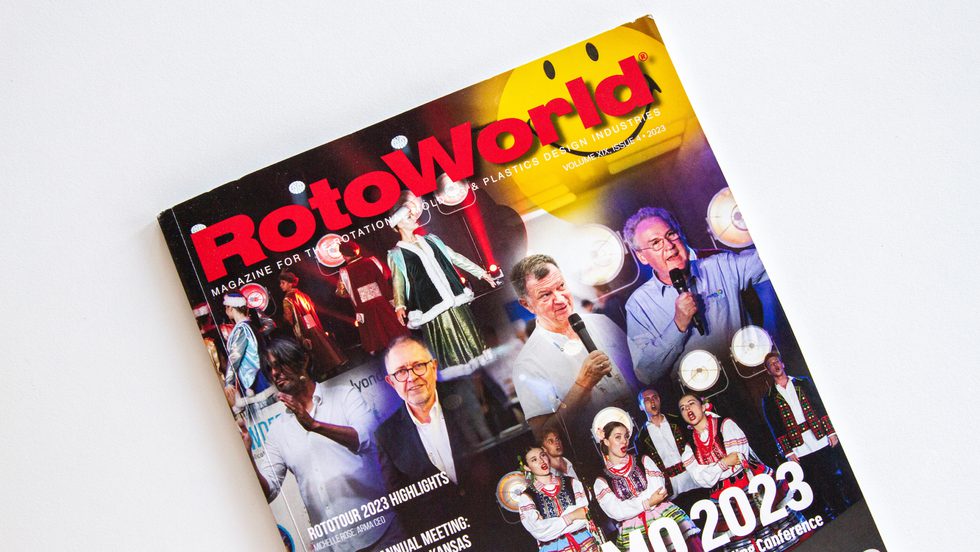
“It was a fun time,” he recalls. “I got to make lots of connections, meet lots of people, and get more experience in that industry.”
Not that Thune (Product Design, 2024) lacked professional experience. After all, experiential learning is baked into the curriculum at CCAD. Here, students are provided real-world classroom and extracurricular learning opportunities, close support from faculty who are active in their industry, and connection to a robust and supportive alumni network, which together lead to a singular goal: meaningful, satisfying employment in the student’s desired career.
And Thune achieved just that, landing a position at Axium Packaging months before he earned his diploma. Here’s a look at how he got there.
Working with clients in the classroom helps students grow as critial thinkers
In CCAD’s Product Design program—formerly known as Industrial Design—students learn to identify problems and create solutions to them while working with a variety of goods, including shoes, boats, scooters, medical devices, and much more. The program is complemented by CCAD’s Creative Careers & Collaboration department, which connects nonprofit, government, and industry employers with faculty and students to create classroom projects that tackle real-world problems.
Creative Careers & Collaboration Associate Vice President Nicole Monahan says projects are designed in part to help students build “power skills” necessary for success in their industry, such as the ability to communicate professionally, collaborate in multi-disciplinary teams, plan for projects, keep to a timetable, and address any challenges that may arise during the work.
Watching Connor grow through his time at CCAD was impactful. I have seen his confidence, collaboration, and leadership grow. All of those skills he built through classroom projects, while also developing excellent technical skills and design abilities.”
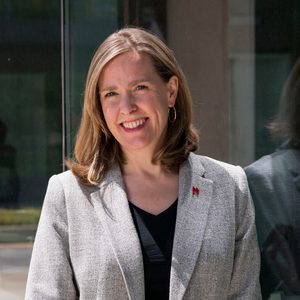 Nicole Monahan
Associate Vice President, Creative Careers & Collaboration
Nicole Monahan
Associate Vice President, Creative Careers & Collaboration
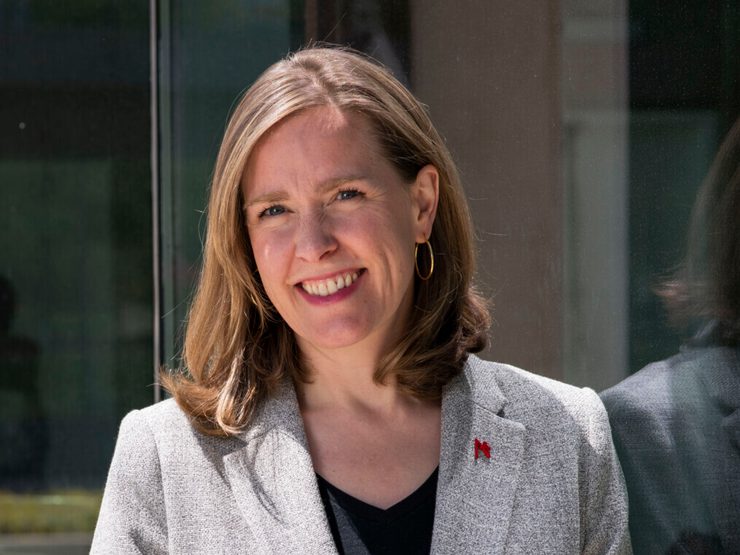
Thune grew up watching his father, Greg Thune (an associate professor of Product Design at CCAD) work. But it took a semester as an undeclared major at another college for him to realize that a career in product design was right for him—and that CCAD offered the classroom learning and professional experience he was looking for. Since then, Thune has worked with multiple national organizations in the classroom.
Autonomous vehicle solutions with 99P Labs
The client: 99P Labs backed by Honda and The Ohio State University
The assignment: This autonomous, shared mobility vehicle project, named “Meraki,” spanned multiple semesters and several groups of students. Thune’s cohort built upon previous classes’ research to design and present a prototype vehicle to 99P Labs. (Read more about this project.)
“It was a super long, super intense project—and a super fun one as well,” says Thune. The students worked in the college woodshop and employed CNC machining equipment, among other tools, to demonstrate the prototype to leaders from 99P Labs and Honda. Thune’s role included presenting CAD (computer-aided design) and exterior work, pushing him to do something he’d once feared: public speaking. “Now … I feel comfortable presenting, and that’s helped me later in internships and other jobs I’ve had,” he says.
In classes, we train on how to present, how to be professional, and how to be confident in your knowledge and what you’re designing. The 99P project helped me gain all those skills, and were significant in leading to internships I went on to do."
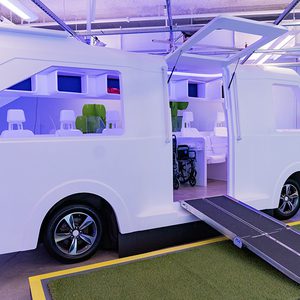 Connor Thune
(Product Design, 2024)
Connor Thune
(Product Design, 2024)
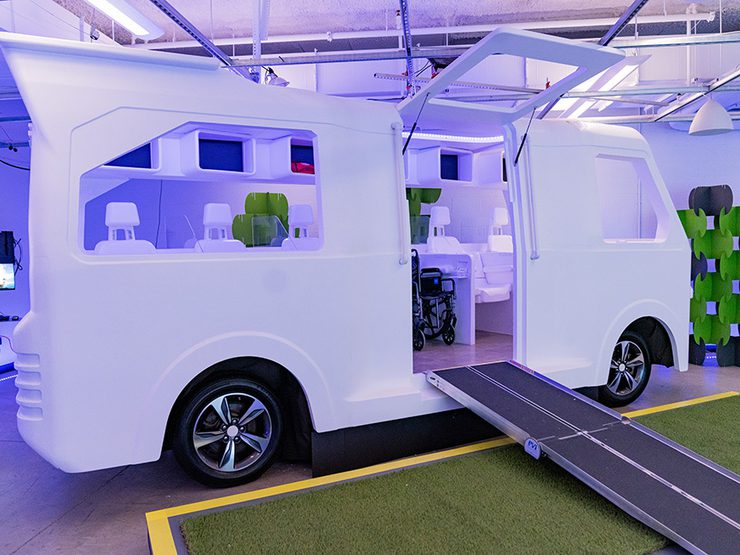
Product design with Rocky Boots
The client: Rocky Boots, an outdoor footwear and workwear brand
The assignment: Students were tasked with creating their own shoe prototypes for Nelsonville, Ohio-based Rocky Boots
Connor started tackling the challenge of designing his own footwear by using Adobe Illustrator to design a lifestyle boot he dubbed “Rugged Rider.” Then Thune and his classmates created tech packs—necessary to ensure that a manufacturer has everything they need to accurately produce a product—to accompany their designs. Tech packs, Thune explains, are created by soft goods manufacturers and reference the materials used, how they will be cut and assembled, where hardware will be placed, where a logo will go, and so on. At the end, Rocky Boots manufactured footwear prototypes for the students to feature in their portfolios.
"That’s been a shocking moment for a lot of interviewers. They’re like, ‘Wow, you actually have a legitimate, physical product that has Rocky Boots’ logo on it.’ ”
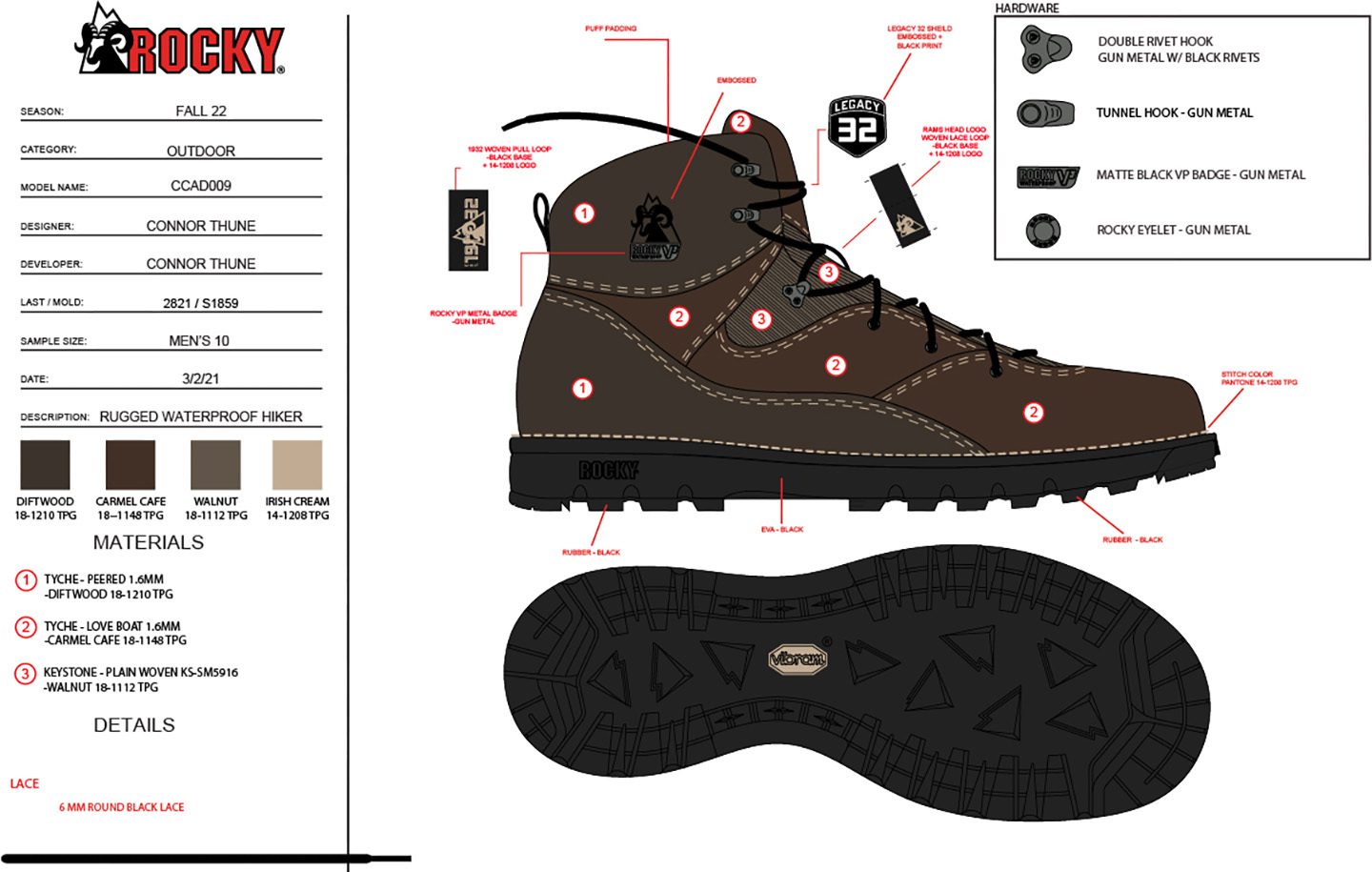
Innovative thinking with Airstream
The client: Airstream, a travel vehicle company headquartered in Jackson Center, Ohio
The assignment: Airstream sought help creating a vehicle to appeal to younger users—and at a lower price point than typical for Airstream products.
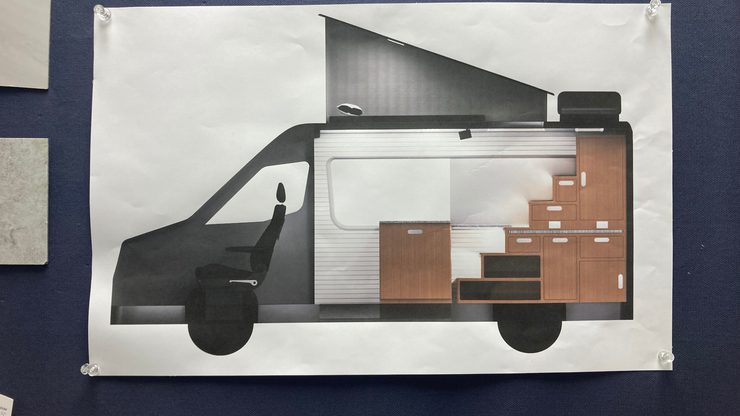
Students examined what features the vehicle—about the size of a sprinter van—needed, and what it could do without, says Thune. The prototype they devised—called Caribou—includes features such as a bed, a pull-out desk, space for a projector screen, room for a coffee maker, and, of course, plenty of storage. Thune credits his classmates for doing much of the research and initial sketches, while he worked on CAD and renderings.
“In our field, we do a lot of work as a team with everybody to try to figure out these complex things,” Thune says.
CCAD EDUCATION HELPS PRODUCT DESIGNER GRADUATE WITH THE WHOLE PACKAGE
The collaborative classroom projects—especially those attached to big-name employers—made Thune a competitive candidate for internships and full-time employment.
“By doing all these projects, someone who’s interviewing you gets to see, ‘wow, OK, They've worked with a team, they've been a team lead. … This person did some good research and it's legitimate stuff,” says Thune.
Thune had not yet graduated from CCAD when Columbus-based Axium Packaging—which produces high-quality plastic packaging for personal care, food, home, hygiene, and other products—hired him as a package designer. The job sees him deepening his design software knowledge, sharpening his skills, and taking on assignments from research all the way to manufacturing. “I’m learning a lot,” he says.

Thune was recruited to the position by Luis Peraza (Product Design, 2014), who leads design and engineering at Axium. (Of note: Peraza himself began working at Axium thanks to a connection made from a classroom project when he was a CCAD student.) Peraza knew that as a CCAD student, Thune would have the right tools and skills for Axium. Indeed, Thune “hit the ground running,” he says.
We don’t have to hold his hand. He’s well-versed and knowledgeable in the programs, and so it feels like there’s no time being wasted."
 Luis Pereza (Product Design, 2014)
Lead Design & Engineering, Axium Packaging
Luis Pereza (Product Design, 2014)
Lead Design & Engineering, Axium Packaging

CCAD has a strong alumni network whose members frequently return to the college to engage in classroom projects and to hire student-interns and graduates. “They know the quality and caliber of a CCAD education as well as the real-world experiences that we’re helping students gain before they leave,” Monahan says.
Thune, she says, “is a total catch. All of his experiences built him into this designer who can be successful in a lot of places. I’m excited to see the impact he’s going to have at Axium.”
Watch the video below to hear more about the skills Connor honed through classroom projects at CCAD, and how those skills helped him land a full-time job.
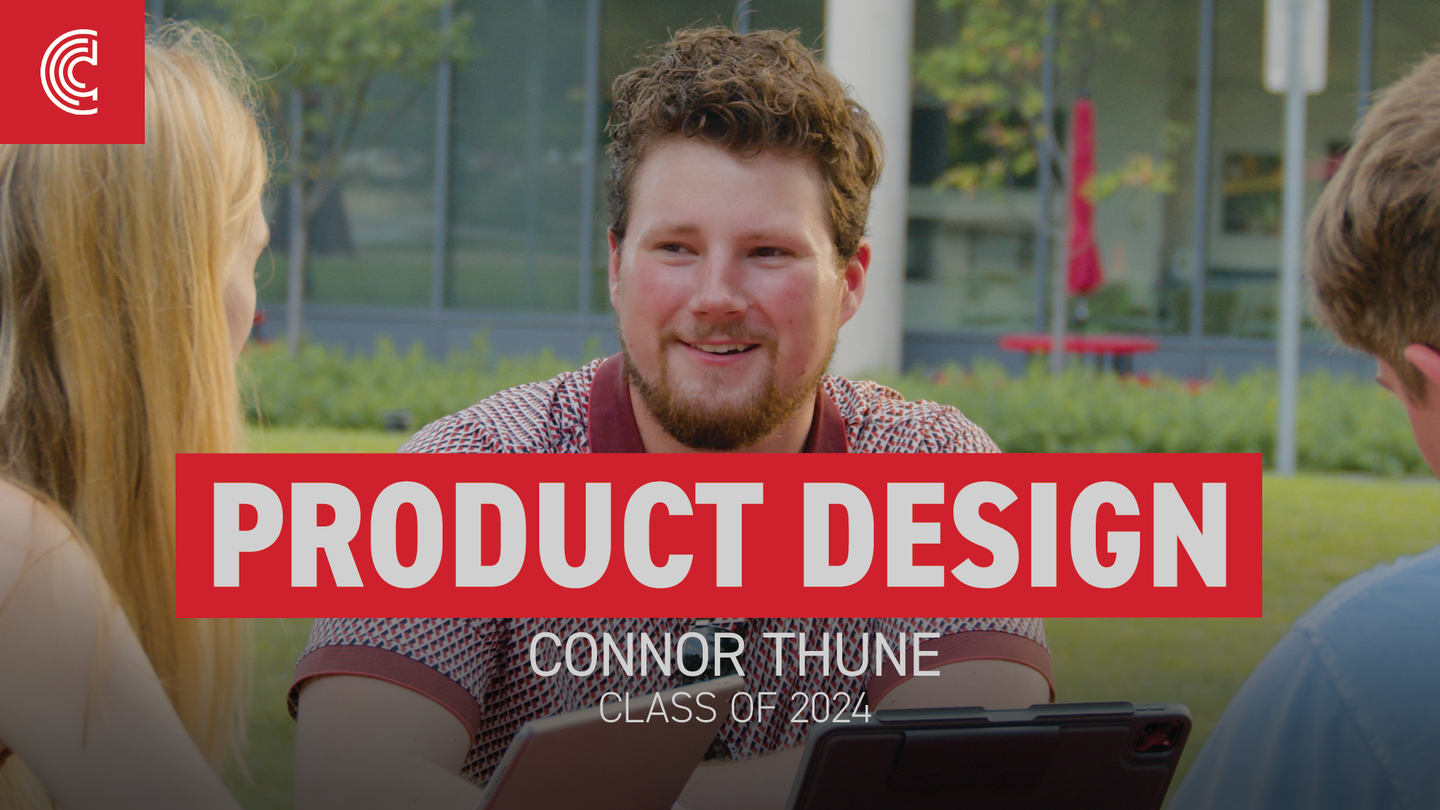
Learn more about Creative Careers & Collaboration at CCAD. Apply here.
See more of Connor Thune’s past projects—and keep up with his current work—on his website.
